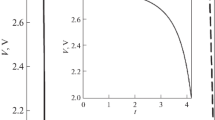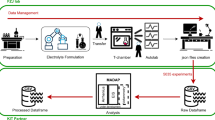Abstract
To optimize the compositions of liquid organic electrolytes for lithium power sources, it is useful to have the dependence of the conductivity on the lithium salt concentration in a convenient analytical form. An empirical formula was suggested on the basis of the modified Kohlrausch equation for the concentration dependence of the conductivity of organic electrolytes in the vicinity of a maximum. The accuracy of this equation was checked on solutions of LiBF4 in propylene carbonate; LiClO4 in ethylene carbonate; and LiPF6 in ethylene carbonate/diethyl carbonate (1: 1), ethylene carbonate/ethylmethyl carbonate (1: 1), and ethylene carbonate/methyl acetate (1: 1) at different temperatures. The calculated data are in good agreement with experiment for all the systems. The new empirical formula allows the determination of the maximum conductivity of organic electrolytes based on a few points with good accuracy, which is very important in choosing the electrolyte salt concentration in practice.
Similar content being viewed by others
References
Huggins, R.A., Advanced Batteries. Materials Science Aspects, New York: Springer Science + Business Media, LLC, 2009.
Lithium-Ion Batteries: Science and Technologies, Masaki, Y., Brodd, R.J., and Kozawa, A.N., Eds., New York: Springer Science + Business Media, LLC, 2009.
Parka, M., Zhanga, X., Chunga, M., Lessa, G.B., and Sastry, A.M., J. Power Sources, 2010, vol. 195, p. 7904.
Kulova, T.L., Russ. J. Electrochem., 2013, vol. 49, p. 1.
Xu, K., Chem. Rev., 2004, vol. 104, p. 4303.
Perdew, P., Burke, K., and Ernzerhof, M., Phys. Rev. Lett., 1996, vol. 77, p. 3865.
Laikov, D.N., Chem. Phys. Lett., 1997, vol. 281, p. 151.
Damaskin, B.B., Petrii, O.A., and Tsirlina, G.A., Elektrokhimiya (Electrochemistry), Moscow: Khimiya, 2006.
Chandra, A., Biswas, R., and Bagchi, B., J. Am. Chem. Soc., 1999, vol. 121, p. 4082.
Pu, W., He, X., Lu, J., Jiang, C., and Wan, C., J. Chem. Phys., 2005, vol. 123, p. 231105.
Fialkov, Yu.Ya. and Suprunenko, A.A., Ukr. Khim. Zh., 1975, vol. 41, p. 1214.
Wolynes, P.G., Ann. Rev. Phys. Chem., 1980, vol. 31, p. 345.
Wolnes, P.G., J. Chem. Phys., 1978, vol. 68, p. 473.
Yarmolenko, O.V., Khatmullina, K.G., Tulibaeva, G.Z., Bogdanova, L.M., and Shestakov, A.F., J. Solid State Electrochem., 2012, vol. 16, p. 3371.
Masia, M., Probst, M., and Rey, R., J. Phys. Chem. B, 2004, vol. 108, p. 2016.
Bhatt, M.D., Cho, M., and Cho, K., Appl. Surf. Sci., 2010, vol. 257, p. 1463.
Bhatt, M.D., Cho, M., and Cho, K., Modell. Simul. Mater. Sci. Eng., 2012, vol. 20, p. 065004.
Ganesh, P., Jiang, D., and Kent, R.P.C., J. Phys. Chem. B, 2011, vol. 115, p. 3085.
Wang, Z., Huang, B.Y., Xue, R.J., Chen, L.Q., and Huang, X.J., J. Electrochem. Soc., 1998, vol. 145, p. 3346.
Bockris, J.O’M. and Reddy, A.K.N., Modern Electrochemistry, New York: Kluwer, 2002.
Chagnes, A., Carre, B., Willmann, P., and Lemordant, D., J. Power Sources, 2002, vol. 109, p. 203.
Chagnes, A., Carre, B., Willmann, P., and Lemordant, D., Electrochim. Acta, 2001, vol. 46, p. 1783.
Scorcelletti, V.V., Teoreticheskaya elektrokhimiya (Theoretical Electrochemistry), Leningrad: GKhI (Gos. Izd. Khim. Lit.), 1974.
Izmailov, N.A., Elektrokhimiya rastvorov (Solution Electrochemistry), Moscow: Khimiya, 1976.
Kutepov, A.M., Eksperimental’nye metody khimii rastvorov (Experimental Methods in Solution Chemistry), Moscow: Nauka, 1997.
Kuratani, K., Uemura, N., Takeshita, H.T., and Kiyobayashi, T., J. Power Sources, 2013, vol. 223, p. 175.
Kolosnitsyn, V.S., Sheina, L.V., and Mochalov, S.E., Russ. J. Electrochem., 2008, vol. 44, p. 575.
Harned, H.S. and Owen, B.B., The Physical Chemistry of Electrolytic Solutions, New York: Reinhold, 1958.
Yurina, E.S., Varlamova, T.M., and Ovsyannikov, V.M., Elektrokhim. Energ., 2003, vol. 3, p. 75.
Linden, D. and Reddy, T.B., Handbook of Batteries, New York: McGraw-Hill, 2002.
Author information
Authors and Affiliations
Corresponding author
Additional information
Original Russian Text © A.F. Shestakov, A.V. Yudina, G.Z. Tulibaeva, K.G. Khatmullina, T.V. Dorofeeva, O.V. Yarmolenko, 2014, published in Elektrokhimiya, 2014, Vol. 50, No. 11, pp. 1143–1151.
Rights and permissions
About this article
Cite this article
Shestakov, A.F., Yudina, A.V., Tulibaeva, G.Z. et al. Empirical formula for the concentration dependence of the conductivity of organic electrolytes for lithium power sources in the vicinity of a maximum. Russ J Electrochem 50, 1027–1035 (2014). https://doi.org/10.1134/S102319351411010X
Received:
Published:
Issue Date:
DOI: https://doi.org/10.1134/S102319351411010X




